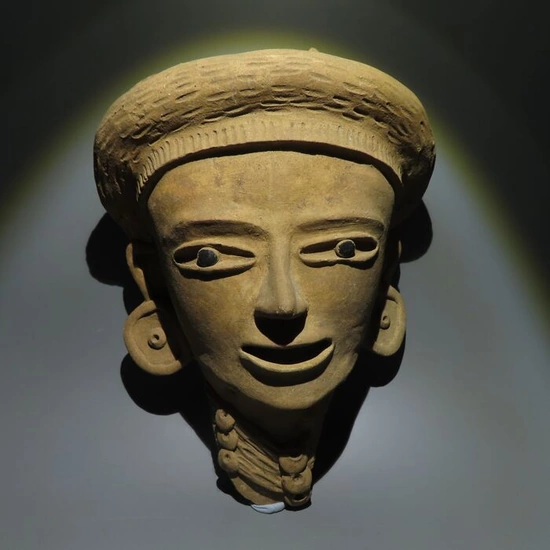Veracruz, México Terracotta Head sculpture. 650-900 AD. 26 cm. H. Spanish Import License
Head sculpture Veracruz, México 550-900 AD Terracotta Height 26 cm PROVENANCE: Private collection, Bengt Söderbergh (1925-2019) , Cannes, Francia. CONDITION: Good condition. See photos. DESCRIPTION: The Veracruz culture, 450 – 900 AD, flourished in a stretch of the Gulf of Mexico’s Atlantic coast. This region of lakes, rivers, and extensive wetlands experiences heavy rainfall, and the lush tropical forest that covers the land is inhabited by animals such as jaguars, tapirs, wild boar, and monkeys. Little is known of the social organization of the Veracruz people, although the existence of ceremonial sites with monumental architecture suggests the presence of leaders capable of organizing a huge workforce. These leaders probably formed a noble class set apart from the rest of the population, which would have consisted mainly of peasants and craftspeople. The religious practices of the Veracruz are also relatively unknown, but at the culture’s zenith the Mesoamerican ball game seems to have been highly important and closely linked to human sacrifices and the afterlife. Ceramics were one of this culture’s characteristic art forms. Notable pieces include human figurines with detailed, life-like faces showing broad smiles and a happy, calm posture. Their highly detailed clothing and unique faces, which are akin to portraits, reflect a high level of expertise. Other figures made by these groups include animals such as jaguars, frogs, bats, and mythical beings. Many articulated figures have also been found, representing animals or persons with wheels. Molds were often used for making ceramic vessels, but finishing touches were done by hand and included modeling and decoration with appliqué and pigments. The remains of pyramids, foundations of temples, and traces of other structures that the Veracruz people built from mud can be found near Remojadas. In the early stages, ceremonial constructions consisted of huts, now long since decayed, built on mounds of earth and loose rock, with floors and low walls of scorched earth. Later sites contained ball courts and stone embankments supporting pyramid structures. During the final stages the Veracruz people built great cities and military fortresses in an effort to defend themselves against invasion by the Aztecs and Toltecs. There is a definite relationship between the Veracruz culture and the ancient Teotihuacán, from which they inherited technical knowledge, aesthetic concepts, and artistic styles. The Veracruz people also were neighbors of the Zapotecs, who lived to the southwest, the Mayas to the southeast, and the Huastecs to the north, and there seems to have been intense trading among these groups. In later periods, local groups formed strong links with the Chichimecs and Nahuas peoples, and ultimately with the Spanish invaders. Notes: - The piece includes authenticity certificate. - The piece includes Spanish Export License. - The seller guarantees that he acquired this piece according to all national and international laws related to the ownership of cultural property. Provenance statement seen by Catawiki.
[ translate ]View it on
Estimate
Time, Location
Auction House
Head sculpture Veracruz, México 550-900 AD Terracotta Height 26 cm PROVENANCE: Private collection, Bengt Söderbergh (1925-2019) , Cannes, Francia. CONDITION: Good condition. See photos. DESCRIPTION: The Veracruz culture, 450 – 900 AD, flourished in a stretch of the Gulf of Mexico’s Atlantic coast. This region of lakes, rivers, and extensive wetlands experiences heavy rainfall, and the lush tropical forest that covers the land is inhabited by animals such as jaguars, tapirs, wild boar, and monkeys. Little is known of the social organization of the Veracruz people, although the existence of ceremonial sites with monumental architecture suggests the presence of leaders capable of organizing a huge workforce. These leaders probably formed a noble class set apart from the rest of the population, which would have consisted mainly of peasants and craftspeople. The religious practices of the Veracruz are also relatively unknown, but at the culture’s zenith the Mesoamerican ball game seems to have been highly important and closely linked to human sacrifices and the afterlife. Ceramics were one of this culture’s characteristic art forms. Notable pieces include human figurines with detailed, life-like faces showing broad smiles and a happy, calm posture. Their highly detailed clothing and unique faces, which are akin to portraits, reflect a high level of expertise. Other figures made by these groups include animals such as jaguars, frogs, bats, and mythical beings. Many articulated figures have also been found, representing animals or persons with wheels. Molds were often used for making ceramic vessels, but finishing touches were done by hand and included modeling and decoration with appliqué and pigments. The remains of pyramids, foundations of temples, and traces of other structures that the Veracruz people built from mud can be found near Remojadas. In the early stages, ceremonial constructions consisted of huts, now long since decayed, built on mounds of earth and loose rock, with floors and low walls of scorched earth. Later sites contained ball courts and stone embankments supporting pyramid structures. During the final stages the Veracruz people built great cities and military fortresses in an effort to defend themselves against invasion by the Aztecs and Toltecs. There is a definite relationship between the Veracruz culture and the ancient Teotihuacán, from which they inherited technical knowledge, aesthetic concepts, and artistic styles. The Veracruz people also were neighbors of the Zapotecs, who lived to the southwest, the Mayas to the southeast, and the Huastecs to the north, and there seems to have been intense trading among these groups. In later periods, local groups formed strong links with the Chichimecs and Nahuas peoples, and ultimately with the Spanish invaders. Notes: - The piece includes authenticity certificate. - The piece includes Spanish Export License. - The seller guarantees that he acquired this piece according to all national and international laws related to the ownership of cultural property. Provenance statement seen by Catawiki.
[ translate ]


